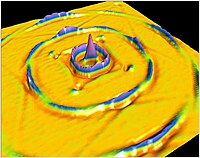
Photo from wikipedia
Abstract Targeting for flexible, broadband ultrasound sensors, a new breed of nanographene platelet (NGP)/polyimide (PI) film is inkjet printed with morphologically optimized NGP/poly (amic acid) hybrid-based nanocomposite ink. The ink… Click to show full abstract
Abstract Targeting for flexible, broadband ultrasound sensors, a new breed of nanographene platelet (NGP)/polyimide (PI) film is inkjet printed with morphologically optimized NGP/poly (amic acid) hybrid-based nanocomposite ink. The ink is produced with high-shear liquid phase exfoliation from inexpensive bulk graphite, manifesting good printability and high graphene concentration as high as 13.1 mg mL−1. Featuring an ultra-thin thickness (∼1 μm only), the inkjet-printed NGP/PI film sensor is demonstrated to possess excellent thermal stability and high adhesive strength reaching the American Society for Testing and Materials 5B level. The highly uniform and consolidated NGP/PI nanostructure in the sensor enables the formation of π-π interaction between NGPs and PI polymer matrix, and the quantum tunneling effect is triggered among NGPs when ultrasound traverses the sensor. This sensing mechanism endows the NGP/PI sensor with good sensitivity, fidelity and accuracy, showing comparable performance as prevailing commercial ultrasound sensors such as piezoelectric sensors. The film sensor has a proven gauge factor as high as 739, when sensing ultrasound at 175 kHz, and an ultrabroad responsive spectrum up to 1.6 MHz.
Journal Title: Carbon
Year Published: 2021
Link to full text (if available)
Share on Social Media: Sign Up to like & get
recommendations!